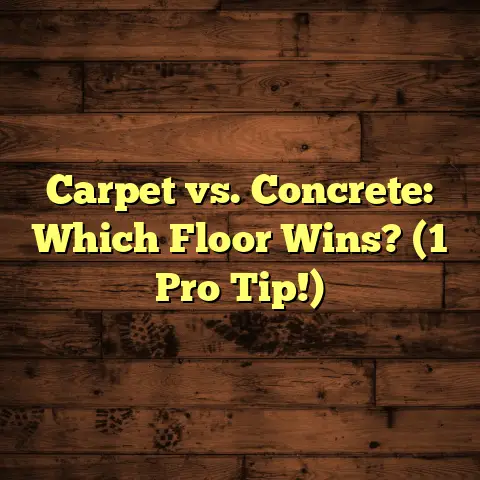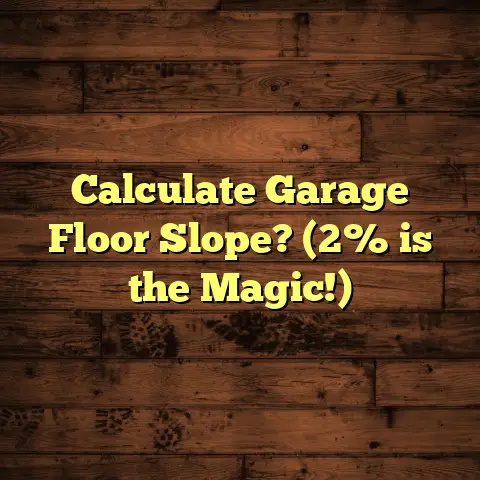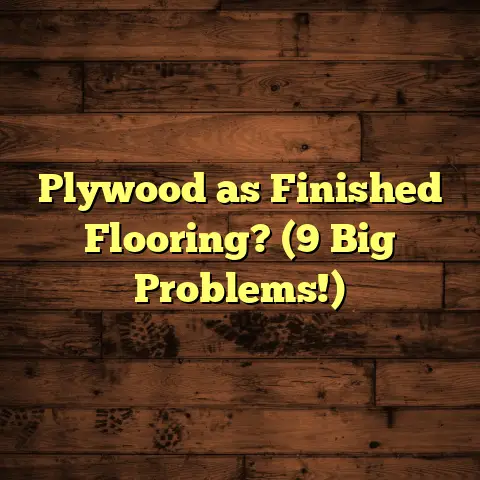Vapor Barrier Under Slab: Do You Need It? (2 Must-Knows!)
Do You Need It? (2 Must-Knows!) – A Guide for Pet Owners
And as a pet owner myself, I know how important it is to choose the right flooring that can stand up to the wear and tear of our furry friends, while keeping them comfortable and safe.
Choosing the right flooring for homes with pets is crucial. It affects their comfort and your home’s health.
But have you ever stopped to think about what’s underneath your flooring?
I’m talking about vapor barriers.
These unsung heroes play a vital role in moisture control under concrete slabs.
They can make all the difference in preventing mold, odors, and costly flooring damage.
Today, we’re diving deep into vapor barriers and why they’re essential, especially if you’re a pet owner.
Keeping our pets safe and comfy should always be top priority when choosing flooring. Trust me, I’ve seen it all!
We’ll cover two must-knows:
-
The necessity of a vapor barrier for moisture control.
-
The implications for pet-friendly flooring options.
So, grab a cup of coffee, and let’s get started!
Section 1: Understanding Vapor Barriers
Okay, let’s start with the basics.
What is a Vapor Barrier?
A vapor barrier is a material used to prevent moisture from passing through walls, floors, and ceilings.
Think of it as a shield against moisture.
Typically, it’s made of polyethylene sheeting, but other materials like foil or specialized coatings can also be used.
These barriers are rated by their permeance, which measures how much moisture can pass through the material.
The lower the permeance, the better the barrier is at blocking moisture.
How Vapor Barriers Work
These barriers stop moisture from rising through concrete slabs.
Without a vapor barrier, moisture from the ground can seep into the concrete.
This can lead to:
- Mold growth.
- Damage to flooring materials.
- Increased humidity.
The vapor barrier creates a protective layer, preventing these issues.
Pet-Friendly Flooring and Moisture
When it comes to pet-friendly homes, popular flooring options include:
- Laminate.
- Vinyl.
- Tile.
Each of these materials reacts differently to moisture.
For example, laminate can swell and warp if exposed to too much moisture, while vinyl and tile are more resistant.
However, even moisture-resistant materials can suffer from mold growth underneath if there’s no vapor barrier.
Risks of Skipping the Vapor Barrier
What happens if you decide to skip the vapor barrier?
Well, the consequences can be pretty nasty.
Without a barrier, moisture can lead to:
- Increased humidity levels.
- Unpleasant odors.
- Degradation of flooring over time.
I’ve seen countless cases where homeowners tried to save a few bucks by skipping the vapor barrier, only to end up with costly repairs down the road.
According to the EPA, high humidity levels can promote the growth of mold and mildew, which can trigger allergies and respiratory issues in both humans and pets. EPA Mold Resources
Real-Life Horror Stories
Let me share a few stories from my own experience.
I once worked with a client who had installed laminate flooring in their basement without a vapor barrier.
They had two adorable golden retrievers.
Within a year, they started noticing a musty smell and their dogs began experiencing respiratory problems.
Upon inspection, we found significant mold growth under the laminate.
The cost to remove the mold, replace the flooring, and address the health issues was far greater than the initial cost of installing a vapor barrier.
Another time, a client with a cat contacted me because their vinyl flooring was bubbling up in several places.
Again, no vapor barrier.
The moisture had caused the adhesive to fail, and the flooring was ruined.
These are just a couple of examples of how skipping a vapor barrier can lead to major headaches.
Here’s a table illustrating the potential impacts of moisture on different flooring types:
| Flooring Type | Impact of Moisture |
|---|---|
| Laminate | Swelling, Warping, Mold |
| Vinyl | Adhesive Failure, Bubbling |
| Tile | Grout Deterioration, Mold |
| Engineered Hardwood | Warping, Delamination |
Section 2: The Importance of a Vapor
Barrier for Pet Owners
Now, let’s talk specifically about why vapor barriers are so crucial for pet owners.
Prioritizing Vapor Barriers
If you’re a pet owner, you should absolutely prioritize installing a vapor barrier under slabs, especially in areas prone to moisture like basements and crawl spaces.
Our furry friends spend a lot of time on the floor, so it’s essential to create a healthy environment for them.
Health Risks and Pets
Moisture in homes can lead to a variety of health risks for both humans and animals.
High humidity levels can exacerbate allergies and respiratory issues.
Pets with allergies are especially vulnerable to mold spores and dust mites that thrive in damp environments.
I’ve seen pets with chronic skin conditions and respiratory problems improve dramatically simply by addressing moisture issues in their homes.
Mold, Mildew, and Your Pets
Moisture can lead to mold and mildew growth, which can be extremely harmful to pets.
Mold spores can cause respiratory infections, allergic reactions, and even neurological problems in some cases.
A vapor barrier mitigates these risks by preventing moisture from creating a breeding ground for mold.
Protecting Your Investment
Let’s face it, flooring isn’t cheap.
Installing a vapor barrier protects your investment by extending the lifespan of your flooring materials.
Without a barrier, moisture can slowly degrade your flooring, leading to premature failure and costly replacements.
I always tell my clients that a vapor barrier is like insurance for their flooring.
It’s a small upfront cost that can save you a lot of money in the long run.
Testimonials from Happy Pet Owners
I’ve worked with many pet owners who’ve seen the benefits of installing a vapor barrier.
One client, Sarah, had a beautiful Bernese Mountain Dog named Bear.
She installed a vapor barrier when she renovated her basement.
“I noticed a huge difference in the air quality,” she told me.
“Bear’s allergies improved, and the basement no longer smells musty.”
Another client, Mark, had two cats and installed a vapor barrier under his new laminate flooring.
“I was worried about moisture from pet accidents,” he said.
“But the vapor barrier has given me peace of mind knowing that my flooring is protected.”
These are just a few examples of how a vapor barrier can make a positive impact on the lives of pet owners.
Section 3: Must-Know Considerations for
Pet Owners
Alright, let’s get to the nitty-gritty.
Here are two must-know considerations for pet owners when it comes to vapor barriers and flooring.
Must-Know #1: Moisture Management is Key
Managing moisture levels is absolutely essential in homes with pets.
Our furry friends can be messy, and accidents happen.
Plus, pets bring in moisture from outside, especially during rainy or snowy weather.
Signs of moisture issues include:
- Musty odors.
- Visible mold or mildew.
- Condensation on windows.
- Warped or bubbled flooring.
These issues can cause discomfort and health problems for your pets.
According to the American Veterinary Medical Association (AVMA), exposure to mold can cause respiratory distress, skin irritation, and even neurological symptoms in pets. AVMA Pet Health
Monitoring Moisture Levels
So, how do you monitor moisture levels in your home?
Here are a few tips:
- Use a hygrometer to measure humidity levels. Aim for a humidity level between 30% and 50%.
- Regularly inspect your flooring for signs of moisture damage.
- Ensure proper ventilation in your home, especially in areas prone to moisture like bathrooms and basements.
- Use a dehumidifier to remove excess moisture from the air.
The vapor barrier plays a crucial role in this process by preventing moisture from rising through the slab.
Must-Know #2: Choosing Pet-Friendly Flooring
Choosing the right flooring is just as important as installing a vapor barrier.
Some flooring options are more durable and moisture-resistant than others.
Here are some of the best flooring options for homes with pets:
- Luxury Vinyl: This is a fantastic option because it’s waterproof, scratch- resistant, and easy to clean.
- Tile: Tile is another excellent choice because it’s highly resistant to moisture and stains.
- Engineered Hardwood: This is a good option if you want the look of hardwood but need something more durable than solid hardwood.
How Flooring Types Respond to Moisture
Each flooring type responds differently to moisture.
Luxury vinyl and tile are virtually impervious to water, while engineered hardwood can withstand some moisture but shouldn’t be exposed to standing water for extended periods.
Laminate is the most vulnerable to moisture, so it’s essential to pair it with a vapor barrier and take extra precautions to prevent spills and accidents.
Pairing your flooring choice with a vapor barrier is essential for maximum effectiveness.
DIY Vapor Barrier Installation Tips
If you’re a DIY enthusiast, you might be wondering if you can install a vapor barrier yourself.
The answer is yes, but it requires careful planning and attention to detail.
Here are a few tips:
-
Choose the Right Material: Opt for a high-quality polyethylene sheeting with a low permeance rating.
-
Prepare the Surface: Make sure the concrete slab is clean, dry, and free of debris.
-
Overlap the Seams: Overlap the seams of the vapor barrier by at least 6 inches and seal them with waterproof tape.
-
Extend Up the Walls: Extend the vapor barrier a few inches up the walls and secure it with tape or adhesive.
-
Be Careful During Installation: Avoid puncturing the vapor barrier during installation.
If you’re not comfortable with DIY projects, I always recommend hiring a professional to ensure the vapor barrier is installed correctly.
Conclusion
Alright, we’ve covered a lot of ground today!
Let’s recap the key points:
- Vapor barriers are essential for preventing moisture from rising through concrete slabs.
- Skipping a vapor barrier can lead to mold growth, odors, and damage to flooring.
- Pet owners should prioritize installing a vapor barrier to protect the health and comfort of their furry friends.
- Managing moisture levels is crucial in homes with pets.
- Choosing the right flooring is just as important as installing a vapor barrier.
By installing a vapor barrier, you’re not only protecting your flooring investment but also ensuring a comfortable and healthy living environment for your pets.
Remember to consider your specific circumstances, including regional climate and types of flooring.
If you’re unsure about anything, don’t hesitate to consult with a professional flooring contractor.
Thanks for joining me today.
I hope this article has been helpful.
Happy flooring!





